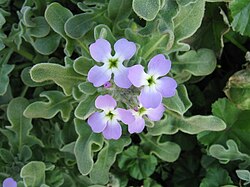| Matthiola tricuspidata | |
|---|---|
 | |
| Habit, with the three horns of the stocks visible | |
 | |
| Close-up of flowers | |
| Scientific classification | |
| Kingdom: | Plantae |
| Clade: | Tracheophytes |
| Clade: | Angiosperms |
| Clade: | Eudicots |
| Clade: | Rosids |
| Order: | Brassicales |
| Family: | Brassicaceae |
| Genus: | Matthiola |
| Species: | M. tricuspidata |
| Binomial name | |
| Matthiola tricuspidata | |
| Synonyms [1] | |
List
| |
Matthiola tricuspidata, the three-horned stock, is a widespread species of flowering plant in the family Brassicaceae, native to the shores of the Mediterranean. [1] A halophyte, it is found in coastal stable dune grassland and coastal dune scrub, but not on shifting coastal dunes. [2]